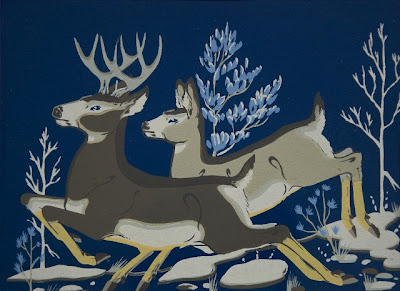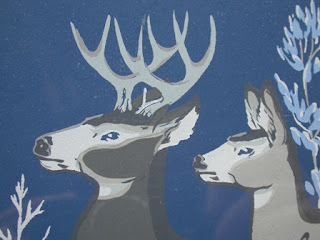
I thought you’d like to read this. After reading my last post, my dad sent me an e-mail that said:
Since I don’t do blogging or Facebook, this will have to do. I enjoyed your vignette of Lena Rhue. When I started reading, I expected to find something about the deer painting at your front door, probably because I took time the other day to look at it closely again and reread what was written on the back. Mom treasured it not just because of its beauty but because, well, as Mom would say, “Lena gave that to me!” Lena gave away a lot of her precious “things.” I suppose many people around central Missouri have mementos of her.
The other thing on my mind is my Mom talked to her about her name, Rhue, which is pronounced just like the German Ruhe, meaning peace. Mom thought it fitted her perfectly—a peaceful lady.
So I will share with you a few views of this painting (actually a silkscreen print), front and back, so you can see for yourself how my grandma treasured this gift.
I believe the work is entitled Frolic. If you search the Internet with the artist’s names, you’ll find more silkscreens of this very image for sale on eBay and elsewhere. (Fifteen bucks!)
I haven’t been able to tell when the original was painted, though the artist, Percy Tsisete Sandy, or Kai Sa (Red Moon), lived from 1918 (he was born on Armistice Day!) to 1974. Apparently Lena Rhue bought this print during a trip to Taos, where, I assume, they were selling them at Carl Schlosser’s trading post (now, I think, it’s part of a bed and breakfast). (The “Knpobo” on the back is Cradle Flower, the wife of Schlosser—Google her name, and you can find many nifty silkscreen prints featuring her poetry.)

Kai Sa studied painting in Albuquerque and at Santa Fe; the “maiden” he married was Peggy Mirabel, from Taos Pueblo. Apparently, Kai Sa became unwelcome in his home pueblo, Zuni, because he had had the temerity to depict sensitive, sacred subjects in his artworks. Thus he relocated to Taos.
Another interesting fact about Kai Sa: He was the illustrator for a children’s book by Ann Nolan Clark entitled Sun Journey: A Story of Zuni Pueblo (1945). (Maybe this is the artwork that got him in trouble with his pueblo?) It’s the story of a ten-year-old Zuni boy who has spent the last three years at a government boarding school and has forgotten or missed out on his own culture. But now, he has returned to his pueblo, and his grandfather and others teach him what it means to be Zuni. Thus, in the course of the book, this child is reintroduced to his people. And the reader learns about Zuni lifeways along with the protagonist.
I think this was a progressive notion for 1945, and I found it even more interesting when I read that the book was originally published by the education branch of the Bureau of Indian Affairs. I had thought the BIA in those years was generally insensitive to Native cultures—and I understand the bureau is still controversial among Native Americans—but here, they employed Clark to provide multicultural educational materials for both Native children and mainstream Americans. Fascinating, huh?

Clark, by the way, was born and educated in New Mexico and spent many years teaching Native American children. She discovered (naturally) that the children learned better when the reading material bore some relation to their own lives, so she ended up writing her own books and primers. She eventually wrote more than forty children’s books that we would today call “multicultural.”

So, Lena Rhue, an unmarried woman and professional sociologist, visited Taos at some point, and I can infer that she had a prescient interest in multiculturalism, too. She gave this picture to my grandma, who in turn gave it to me, in 1993. And now I get to look at it every time I head out the front door—and feel layers of appreciation.








No comments:
Post a Comment